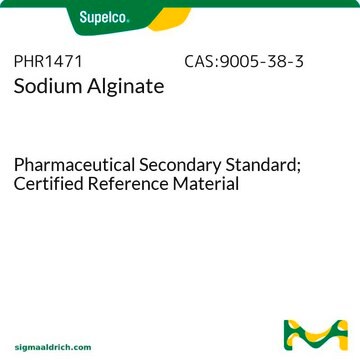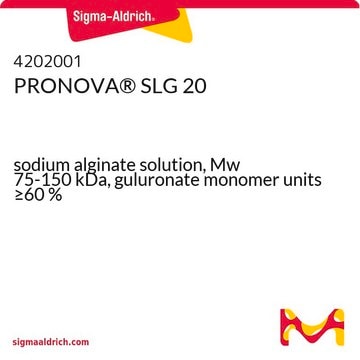918652
Low endotoxin alginate solution
Medium viscosity, 0.2 μm, sterile-filtered
Sinônimo(s):
Alginic acid, Sodium alginate
Faça loginpara ver os preços organizacionais e de contrato
About This Item
Código UNSPSC:
12162002
NACRES:
NA.23
Produtos recomendados
Nível de qualidade
esterilidade
sterile-filtered
forma
viscous liquid
concentração
1.75-3.50 wt. % in DPBS (buffer)
Impurezas
<10 EU/g Endotoxin
<5 CFU/g Bioburden (Fungal)
<5 CFU/g Bioburden (Total Aerobic)
cor
colorless to pale yellow
tamanho de partícula
0.2 μm
pH
6.5-7.5
temperatura de armazenamento
2-8°C
Categorias relacionadas
Aplicação
Low endotoxin alginate solution is a 2 % low endotoxin alginate solution in DPBS buffer. It is sterile filtrated through 0.2 μm sterile filter, and ready to be used in biomedical applications.
Alginate is an anionic polysaccharide that is widely used in pharmaceutical and biomedical applications due to its non-animal origin, low toxicity, biocompatibility, and biodegradability. Alginate hydrogels are commonly used to fabricate tissue engineering scaffolds, bioinks for 3D bioprinting, and nanocarriers for drug & gene delivery. Alginate is commonly crosslinked into a hydrogel via ionic-crosslinking with divalent cations (e.g., Ca2+).
Alginate is an anionic polysaccharide that is widely used in pharmaceutical and biomedical applications due to its non-animal origin, low toxicity, biocompatibility, and biodegradability. Alginate hydrogels are commonly used to fabricate tissue engineering scaffolds, bioinks for 3D bioprinting, and nanocarriers for drug & gene delivery. Alginate is commonly crosslinked into a hydrogel via ionic-crosslinking with divalent cations (e.g., Ca2+).
Embalagem
10 mL in glass bottle
Código de classe de armazenamento
12 - Non Combustible Liquids
Classe de risco de água (WGK)
WGK 2
Certificados de análise (COA)
Busque Certificados de análise (COA) digitando o Número do Lote do produto. Os números de lote e remessa podem ser encontrados no rótulo de um produto após a palavra “Lot” ou “Batch”.
Já possui este produto?
Encontre a documentação dos produtos que você adquiriu recentemente na biblioteca de documentos.
Jia Jia et al.
Acta biomaterialia, 10(10), 4323-4331 (2014-07-08)
Recent advances in three-dimensional (3-D) printing offer an excellent opportunity to address critical challenges faced by current tissue engineering approaches. Alginate hydrogels have been used extensively as bioinks for 3-D bioprinting. However, most previous research has focused on native alginates
Eneko Axpe et al.
International journal of molecular sciences, 17(12) (2016-11-30)
Three-dimensional (3D) bioprinting is on the cusp of permitting the direct fabrication of artificial living tissue. Multicellular building blocks (bioinks) are dispensed layer by layer and scaled for the target construct. However, only a few materials are able to fulfill
Kuen Yong Lee et al.
Progress in polymer science, 37(1), 106-126 (2011-11-30)
Alginate is a biomaterial that has found numerous applications in biomedical science and engineering due to its favorable properties, including biocompatibility and ease of gelation. Alginate hydrogels have been particularly attractive in wound healing, drug delivery, and tissue engineering applications
Tarun Agarwal et al.
ACS applied materials & interfaces, 8(47), 32132-32145 (2016-12-10)
Success of bone tissue engineering (BTE) relies on the osteogenic microarchitecture of the biopolymeric scaffold and appropriate spatiotemporal distribution of therapeutic molecules (growth factors and drugs) inside it. However, the existing technologies have failed to address both the issues together.
Nossa equipe de cientistas tem experiência em todas as áreas de pesquisa, incluindo Life Sciences, ciência de materiais, síntese química, cromatografia, química analítica e muitas outras.
Entre em contato com a assistência técnica





